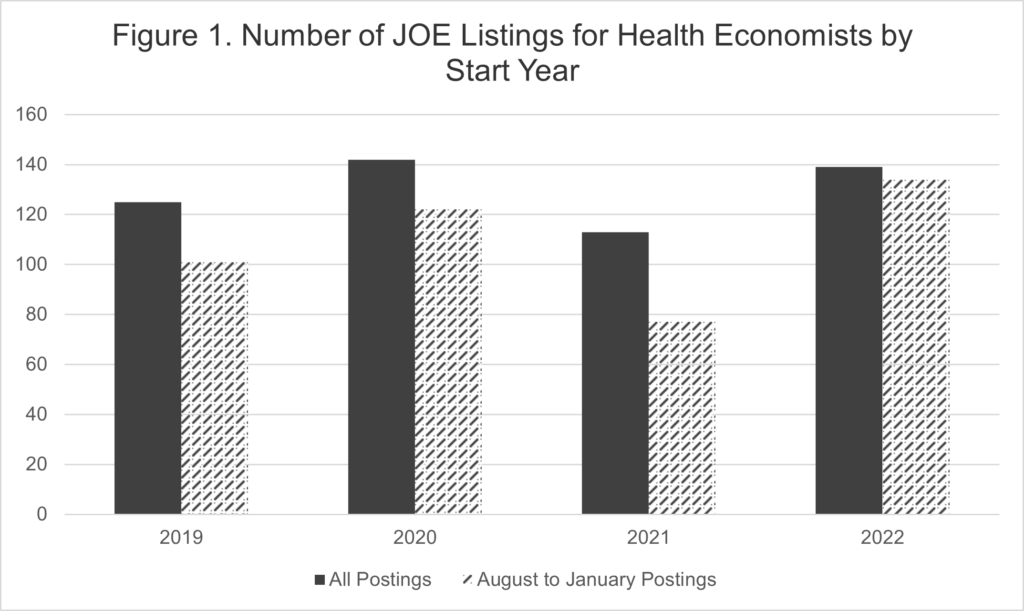
By Anne M. Burton
It’s that time of year where the job market is in full swing, and job market candidates and departments are busy with flyouts and hiring decisions. Anecdotes about how the market fares relative to other years are common, in this article, we review the data on job openings for health economists and describe some trends on how demand for health economists has evolved. Overall, we document 2 important facts: 1) omitting the 2020-2021 hiring year, the number of jobs for health economists has increased; and 2) this increase is being driven mostly by the U.S. academic sector, particularly non-economics departments.
About the data
We obtained data on job postings from the AEA’s JOE listings from February 1, 2018 to January 25, 2022. As such, they exclude jobs for health economists that were posted on other websites. They include all postings that indicated a desire for a health economist with a Ph.D. (JEL code I1—health, keywords such as “health economics” or “health care”, or a mention of the field of health economics in the full-text description). This analysis measures the number of job postings; in some instances, multiple jobs are listed in one posting.
Postings were assigned to approximated start dates (2019, 2020, 2021, or 2022) based on their AEA listings cycle (the AEA cycles run from February 1 to July 31 and August 1 to January 31). All jobs posted during the August 1 to January 31 AEA listings cycle were assumed to have start dates for later that year (e.g. jobs posted from August 1, 2020 to January 31, 2021 were assumed to have 2021 start dates). Jobs posted by April 1 or with an application deadline of April 30 were assumed to have start dates in the same year. Any remaining jobs in the February to July listings cycle were hand checked for mentions of start dates. You can find the data here: https://annemburton.com/assets/joe_results_public.xls.
Trends in job postings
Demand for health economists in 2022 is up 11.2% relative to 2019, as shown in Figure 1. This increase masks larger year-to-year fluctuations in demand. Consistent with the overall job market for Ph.D. economists, the number of job postings for health economists fell with the onset of the COVID-19 pandemic (AEA ad hoc Committee on the Job Market, 2021). There were 125 job postings for health economists with a start date of 2019, and 142 jobs with a start date of 2020; both of these presumably reflect decisions made by organizations pre-pandemic. There was a drop to 113 jobs with a start date of 2021, and 139 jobs with a start date of 2022; both of which presumably reflect hiring decisions made during the pandemic.[1],
[1] The final number of job openings with a 2022 start date may be higher as some jobs are posted in February or later.
[2] Job openings with a 2020 start date for health economists were up 13.6% relative to 2019, then fell 20.4% in 2021 before rebounding 23% in 2022.

To explore whether the composition of the type of health economist jobs has been changing in recent years, we broke down the number of jobs into sector and department/position type. Figure 2 shows the number of U.S. full-time academic, U.S. other academic (e.g., postdoctoral positions), U.S. nonacademic (government, think tanks, and consulting), and international job openings for health economists. With the exception of 2021 start dates, U.S. full-time academic jobs have been increasing in recent years (black line with triangle markers in Figure 2). There were 49 job openings with 2019 start dates, 55 postings for 2020 (12.2% increase), 31 postings for 2021 (43.6% decrease), and 67 openings with 2022 start dates (116.1% increase over 2021 and a 21.8% increase over 2020). Demand for U.S. other academic job postings has been relatively constant, with 19 openings in 2019 and 2021, 20 openings in 2020, and 22 openings in 2022 (dark gray line with diamond markers in Figure 2). Demand for U.S. nonacademic jobs was steady throughout the onset of the COVID-19 pandemic but has fallen in the past year, with the caveat that these types of jobs sometimes have later posting dates, which means demand may pick up in the coming months (light gray line with square markers in Figure 2). There were 37 nonacademic job postings with 2019 start dates, 41 each with 2020 and 2021 start dates, and 29 (thus far) with 2022 start dates. Relative to U.S. full-time academic jobs, international job openings appear to be relatively less affected by the COVID-19 pandemic (gray line with circle markers in Figure 2). There were 15 international jobs with 2019 start dates, 24 jobs with 2020 start dates (60% increase), 19 jobs with 2021 start dates (20.8% decrease), and 18 jobs with 2022 start dates (5.3% decrease).
[1] Departments and organizations typically make decisions about job postings months to a year in advance of the desired start date. Jobs with 2019 start dates were typically decided in 2018 by organizations and jobs with 2020 start dates were often decided in 2019. The 2021 dip in jobs reflects the suppressed demand from the pandemic, as those jobs were decided in 2020.

Figure 3 focuses on demand for academic jobs for health economists, broken down into U.S. economics departments, U.S. non-economics departments, international economics departments, and postdoctoral positions. Full-time academic positions in U.S. economics departments were down a touch even before the onset of the COVID-19 pandemic (solid black bars in Figure 3). There were 19 such job postings with a 2019 start date, 16 postings with a 2020 start date (15.8% decrease), 7 postings with a 2021 start date (56.3% decrease), and 22 postings with a 2022 start date (214.3% increase over 2021 and a 37.5% increase over 2020). As seen in the graph, the bulk of academic jobs in the U.S. for health economists come from non-economics departments (striped bars in Figure 3). There were 30 postings for non-economics departments with start dates in 2019, 39 postings for 2020 (30% increase), 24 postings for 2021 (38.5% decrease), and 45 postings for 2022 (87.5% increase over 2021 and 50% increase over 2020). Jobs in international economics departments comprise a small share of academic JOE listings, as seen by the dotted bars in Figure 3 (keep in mind that more international listings may be posted on sites like econjobmarket.org). There were 5 openings with start dates in 2019, 9 postings for 2020, 3 postings for 2021, and 5 postings for 2022. Finally, demand for health economist postdocs has been steady the last few years (gray bars in Figure 3). There were 19 postdoctoral openings with start dates in 2019, 22 each for 2020 and 2021, and 24 openings for 2022.

References
AEA ad hoc Committee on the Job Market. 2021. “JOE Job Openings by Sector, 2021 versus 2020 and 2019.” Version updated November 23, 2021. https://www.aeaweb.org/joe/communications/joe-by-sector-11-2021-updated
American Economic Association. 2022. “JOE Listings.” https://www.aeaweb.org/joe/listings
Burton, Anne M. 2022. “Historical Data on JOE Listings for Health Economists.” https://annemburton.com/pages/resources.html
